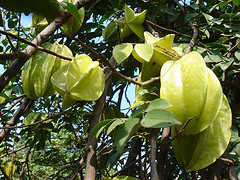Starfruit
| Infobox on Starfruit | |
|---|---|
| Example of Starfruit |  |
| Freshness facts | |
| Optimum carrying temperature | 5°C to 10°C (depending on cultivar and production area) |
| Highest freezing point | - |
| Acceptable product temp. at loading into containers | Max. 2°C above carrying temperature |
| Optimum humidity | 90% |
| Ventilation setting for containers | 10 m³/hr |
| Storage life | 3 to 5 weeks |
| Climacteric / non-climacteric | Non-climacteric |
| Ethylene production | Low |
| Ethylene sensitivity | Low |
| Modified / controlled atmosphere | See text |
| Potential benefits | See text |
| Availability | |
| South America Israel |
April - October August - April |
Starfruit
Contents
Harvesting and handling
Harvesting is based on physiological and horticultural maturity as indicated by skin colour change from green to yellowish-green, then to full yellow or yellowish-orange. Optimum sugars are achieved at the full yellow colour, however, ripe fruit are more fragile and easily damaged, hence, fruit are frequently harvested at the colour break stage. Fruit that are 50% to 70% yellow are firmer than full-colour fruit, and hence are regarded as commercially mature. Fruit continue to develop colour after harvest, although there is little other change in quality. Carambola is a non-climacteric fruit.
The major problem is physical injury, especially on the rib edges, that leads to browning. Injury due to abrasion and impact can be avoided by careful handling. Browning due to mechanical injury can intensify with water loss. Fruit that have lost about 5% of their weight due to water loss show visible symptoms of dehydration.
Cooling and storage
(Pre-)cool to 4°C to 10°C by forced-air room-cooling as soon as possible after harvest.
Though a tropical fruit, Carambolas can be stored at 5°C with 90% to 95% relative humidity for 3 to 5 weeks. The length of storage varies with ripeness when placed in storage. Lower relative humidity results in more severe rib edge browning; if held at 20°C and 60% relative humidity, the fruit has a storage-life of 3 to 4 days.
Carambolas are not especially chilling sensitive. However, during low temperature storage at 0°C or 5°C for 2 and 6 weeks, respectively, some small surface pitting and rib edge browning can occur. The severity of injury increases with storage time. Greener fruit are more susceptible to injury. This symptom can also be seen with desiccation and may not be true chilling injury. Humidity lower than 90% results in more severe symptoms of rib browning.
Waxing also delays water loss and de-greening.
Mixed loads
-
Controlled Atmosphere (CA) consideration
Fruit held at 7°C in 2,2% to 4,2% O2 with 8% to 8,2% CO2 retained colour and firmness more than fruit held in air.
Storage disorders
Alternaria rot, Chilling injury, Cladosporium cladosporiodes, Botryodiplodia theobromae.











